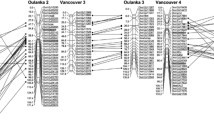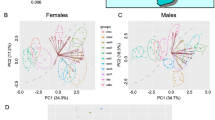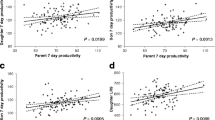Abstract
The role of dominance and epistasis in population divergence has been an issue of much debate ever since the neoDarwinian synthesis. One of the best ways to dissect the several genetic components affecting the genetic architecture of populations is line cross analysis. Here we present a study comparing generation means of several life history-traits in two closely related Drosophila species: Drosophila subobscura, D. madeirensis as well as their F 1 and F 2 hybrids. This study aims to determine the relative contributions of additive and non-additive genetic parameters to the differentiation of life-history traits between these two species. The results indicate that both negative dominance and epistatic effects are very important in the differentiation of most traits. We end with considerations about the relevance of these findings for the understanding of the role of non-additive effects in speciation.

Similar content being viewed by others
References
Aspi J (2000) Inbreeding and outbreeding depression in male courtship song characters in Drosophila montana. Heredity 84:273–282
Baierl A, Bogdan M, Frommlet F, Futschik A (2006) On locating multiple interacting quantitative trait loci in intercross designs. Genetics 173:1693–1703
Barton NH, Turelli M (1989) Evolutionary quantitative genetics: how little do we know? Annu Rev Genet 23:337–370
Bieri J, Kawecki T (2003) Genetic architecture of differences between populations of cowpea weevil (Callosobruchus maculatus) evolved in the same environment. Evolution 57:274–287
Blanc G, Charcosset A, Mangin B, Gallais A, Moreau L (2006) Connected populations for detecting quantitative trait loci and testing for epistasis: an application in maize. Theor Appl Genet 113:206–224
Blows MW, Sokolowski MB (1995) The expression of additive and nonadditive genetic variation under stress. Genetics 140:1149–1159
Bradshaw WE, Haggerty BP, Holzapfel CM (2005) Epistasis underlying a fitness trait within a natural population of the pitcher-plant mosquito, Wyeomyia smithii. Genetics 169:485–488
Breeuwer JAJ, Werren JH (1995) Hybrid breakdown between two haplodiploid species: the role of nuclear and cytoplasmic genes. Evolution 49:705–717
Brown AF (1991) Outbreeding depression as a cost of dispersal in the harpacticoid copepod Tigriopus californicus. Biol Bull 181:123–126
Burton RS (1990) Hybrid breakdown in developmental time in the copepod Tigriopus Californicus. Evolution 44:1814–1822
Carrol SP, Dingle H, Famula TR (2001) Genetic architecture of adaptive differentiation in evolving host races of the soapberry bug, Jadera haematoloma. Genetica 112/113:257–272
Carrol SP, Dingle H, Famula TR (2003) Rapid appearance of epistasis during adaptive divergence following colonization. Proc R Soc Lond Ser B 270(Suppl. 1):S80–S83
Coyne JA (1992) Genetics and speciation. Nature 355:511–515
Coyne JA, Barton NH, Turelli M (1997) A critique of Wright’s shifting balance theory of evolution. Evolution 51:643–671
Coyne JA, Barton NH, Turelli M (2000) Is Wright’s shifting balance process important in evolution? Evolution 54:306–317
Coyne JA, Orr A (1989) Patterns of speciation in Drosophila. Evolution 43:362–381
Coyne JA, Orr A (1997) Patterns of speciation in Drosophila revisited. Evolution 51:295–303
Crnokrak P, Roff DA (1995) Dominance variance: associations with selection and fitness. Heredity 75:530–540
Edmands S (1999) Heterosis and outbreeding depression in interpopulation crosses spanning a wide range of divergence. Evolution 53:1757–1768
Facon B, Jarne P, Pointier JP, David P (2005) Hybridization and invasiveness in the freshwater snail Melanoides tuberculata: hybrid vigour is more important than increase in genetic variance. J Evol Biol 18:524–535
Fenster CB, Galloway LF, Chao L (1997) Epistasis and its consequences for the evolution of natural populations. Trends Ecol Evol 12:282–286
Fenster CB, Galloway LF (2000) Population differentiation in an annual legume: genetic architecture. Evolution 54:1157–1172
Fisher RA (1930) The genetical theory of natural selection. Oxford University Press. UK
Fox CW, Stillwell RC, Amarillo AR, Czesak ME, Messina FJ (2004) Genetic architecture of population differences in oviposition behaviour of the seed beetle Callosobruchus maculatus. J Evol Biol 17:1141–1151
Fritz RS, Hochwender CG, Brunsfeld SJ, Roche BM (2003) Genetic architecture of susceptibility to herbivores in hybrid willows. J Evol Biol 16:1115–1126
Gavrilets S (2004) Fitness landscapes and the origin of species. Princeton University Press, Princeton
Gilchrist AS, Partridge L (1999) A comparison of the genetic basis of wing size divergence in three parallel body size clines of Drosophila melanogaster. Genetics 153:1775–1787
Goodnight CJ, Wade MJ (2000) The ongoing synthesis: a reply to Coyne, Barton and Turelli. Evolution 54:317–324
Hatfield T (1997) Genetic divergence in adaptive characters between sympatric species of sticlebacks. Am Nat 149:1009–1029
Jonhson NA (2002) Sixty years after Isolating mechanisms, evolution and temperature Muller’s legacy. Genetics 161:939–944
Kearsey MJ, Pooni HS (1996) The genetical analysis of quantitative traits. Chapman and Hall, London
Khadem M, Krimbas CB (1991) Studies of the species barrier between Drosophila subobscura and D. madeirensis I. The genetics of male hybrid sterility. Heredity 67:157–165
Khadem M, Krimbas CB (1993) Studies of the species barrier between Drosophila subobscura and D. madeirensis III. How universal are the rules of speciation? Heredity 70:353–361
Khadem M, Krimbas CB (1997) Studies of the species barrier between Drosophila subobscura and Drosophila madeirensis IV. A genetic dissection of the X chromosome for speciation genes. J Evol Biol 10:909–920
Lair KP, Bradshaw WE, Holzapfel CM (1997) Evolutionary divergence of the genetic architecture underlying photoperiodism in the pitcher-plant mosquito, Wyeomyia smithii. Genetics 147:1873–1883
Leberg PL (1993) Strategies for population reintroduction: effects of genetic variability on population growth and size. Conserv Biol 7:194–199
Li Z, Pinson SRM, Park WD, Paterson AH, Stansel JW (1997a) Epistasis for three grain yield components in rice (Oryza sativa L.). Genetics 145:453–465
Li Z, Pinson SRM, Paterson AH, Park WD, Stansel JW (1997b) Genetics of hybrid sterility and hybrid breakdown in an intersubspecific rice (Oryza sativa L.) population. Genetics 145:1139–1148
Lynch M (1991) The genetic interpretation of inbreeding depression and outbeeding depression. Evolution 45:622–629
Lynch M, Walsh B (1998) Genetics and analysis of quantitative traits. Sinauer, Sunderland
Macnair MR, Cumbs QJ (1989) The genetic architecture of interspecific variation in Mimulus. Genetics 122:211–222
Matos M, Rose MR, Rocha Pité MT, Rego C, Avelar T (2000) Adaptation to the laboratory environment in Drosophila subobscura. J Evol Biol 13:9–19
Matos M, Avelar T, Rose MR (2002) Variation in the rate of convergent evolution: adaptation to a laboratory environment in Drosophila subobscura. J Evol Biol 15:673–682
Mather K, Jinks JL (1982) Biometrical genetics: the study of continuous variation, 3rd edn. Chapman and Hall, London
Orr HA (2001) The genetics of species differences. Trends Ecol Evol 16:343–350
Orr HA, Irving S (2001) Complex epistasis and the genetic basis of hybrid sterility in the Drosophila pseudoobscura Bogota-USA hybridization. Genetics 158:1089–1100
Papaceit M, San Antonio J, Prevosti A (1991) Genetic analysis of extra sex combs in the hybrids between Drosophila subobscura and D. madeirensis. Genetica 84:107–114
Ramos-Onsins S, Segarra C, Rozas J, Aguadé M (1998) Molecular and chromossomal phylogeny in the obscura group of Drosophila inferred from sequences of the rp49 gene region. Mol Phylogenet Evol 9:33–41
Rego C, Matos M, Santos M (2006) Symmetry breaking in interspecific Drosophila hybrids is not due to developmental noise. Evolution 60:746–761
Starmer WT, Polak M, Wolf LL, Barker JSF (1998) Reproductive characteristics of the flower breeding Drosophila hibisci Bock (Drosophilidae) in eastern Australia: genetic and environmental determinants of ovariole number. Evolution 52:806–815
Templeton AR (1981) Mechanisms of speciation—a population genetic approach. Annu Rev Ecol Syst 12:23–48
Tanksley SD (1993) Mapping polygenes. Annu Rev Genet 27:205–233
Teotónio H, Matos M, Rose MR (2004) Quantitative genetics of functional characters in Drosophila melanogaster populations subjected to laboratory selection. J Genet 83:265–277
Turelli M, Orr HA (2000) Dominance, epistasis and the genetics of postzygotic isolation. Genetics 154:1663–1679
Wade MJ (2002) A gene’s eye view of epistasis, selection and speciation. J Evol Biol 15:337–346
Wade MJ, Goodnight CJ (1998) The theories of Fisher and Wright in the context of metapopulations: when nature does many small experiments. Evolution 52:1537–1553
Whitlock MC, Phillips PC, Moore FBG, Tonsor S (1995) Multiple fitness peaks and epistasis. Annu Rev Ecol Syst 26:601–609
Waser NM, Price MV (1989) Optimal outcrossing in Ipomopsis aggregata: seed set and offspring fitness. Evolution 43:1097–1109
Waser NM, Price MV (1994) Crossing distance effects in Delphinium nelsonii: outbreeding and inbreeding depression in progeny fitness. Evolution 48:842–852
Wright S (1977) Evolution and the genetics of populations. Vol. 3 Experimental results and evolutionary deductions. University of Chicago Press, Chicago
Acknowledgments
The authors wish to thank M. T. Pité for supervising the initial stages of this work; Anabela Cardoso, António Brehm and Ana Paula Andrade for their valuable assistance in collecting flies; and Ana Duarte, Mário Boieiro, Pedro Simões, Raquel Gonçalves and Teresa Rebelo, for their help during laboratorial work. CR received a grant from Fundação para a Ciência e Tecnologia (PRAXIS XXI//BD/21479/99). MS is partially supported by Fundación Ramón Areces (Spain). This work was partially accomplished within the Acción Integrada Hispano-Portuguesa HP2003-0099, and the Acções Integradas Luso-Espanholas E-36/04.
Author information
Authors and Affiliations
Corresponding author
Rights and permissions
About this article
Cite this article
Rego, C., Santos, M. & Matos, M. Quantitative genetics of speciation: additive and non-additive genetic differentiation between Drosophila madeirensis and Drosophila subobscura . Genetica 131, 167–174 (2007). https://doi.org/10.1007/s10709-006-9128-z
Received:
Accepted:
Published:
Issue Date:
DOI: https://doi.org/10.1007/s10709-006-9128-z




